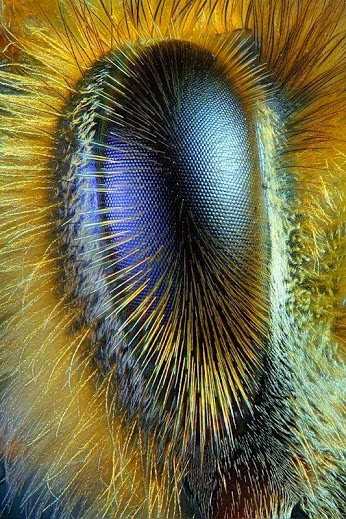 El aparato visual de las abejas está formado por dos grandes ojos compuestos situados en posición dorso-lateral de la cabeza y tres pequeños ocelos (pequeños ojos) organizados en triangulo en la parte frontal de la misma.
El aparato visual de las abejas está formado por dos grandes ojos compuestos situados en posición dorso-lateral de la cabeza y tres pequeños ocelos (pequeños ojos) organizados en triangulo en la parte frontal de la misma.
Los ojos compuestos formados por 6000 omatidios no ven con nitidez, por ello las abejas tienen que acercarse a una distancia de 5 cm de una flor para distinguirla de las plantas y hojas; aunque para esta labor utilizan también las antenas que son el olfato, oído y tacto de las abejas, describe la especialista.
En cuanto a la de percepción de los colores las abejas perciben los colores del mundo que las rodea de manera muy distinta respecto a los vertebrados superiores, los pétalos pueden parecer de color uniforme pero éstos presentan áreas que reflejan la luz ultravioleta que guían las abejas hacia la fuente de polen, garantizando de esa manera la polinización, destaca la misma especialista.
Los ojos simples “ojos primitivos” llamados ocelos, estos fotorreceptores no perciben imágenes sino solamente la intensidad de la luz, incluida la luz polarizada, de esa manera pueden localizar el sol también en condiciones nubladas y por eso resultan tan importantes para su orientación.
Las abejas al ocaso del día aprovechan esta percepción de intensidad lumínica solar para estimar la hora del día y calculan sí disponen de tiempo suficiente para recorrer la distancia de vuelta a su colonia.
Siendo el objetivo de las abejas encontrar el polen escondido en las flores más llamativas, entonces adaptan su visión en función de su vuelo o búsqueda de alimentos. Y los tres ojos primitivos adicionales le ayudan a saber la hora solar.
Además tienen una elevada sensibilidad óptica al movimiento, los pequeños y rápidos movimientos son percibidos de manera clara, como un pase de fotografías sin movimiento.
VISUAL BEE APPARATUS.
The visual apparatus of the bees consists of two large compound eyes located in the dorso-lateral position of the head and three small ocelli (small eyes) organized in triangle in the front part of the same.
The compound eyes formed by 6000 omatides do not see clearly, so the bees have to approach a distance of 5 cm from a flower to distinguish it from plants and leaves; Although for this work also the antennas that are the smell, the ear and the touch of the bees are used, the specialist describes.
As far as the perception of the colors of the bees perceive the colors of the world that surrounds them very different from the superior vertebrates, the petals can appear of uniform color, but these have areas that reflect the ultraviolet light that guide the bees toward the source Of pollen, thus ensuring pollination, stresses the same specialist.
The simple eyes "primitive eyes" called ocelli, these photoreceptors do not perceive images but only the intensity of light, including polarized light, so that they can locate the sun also in cloudy conditions and therefore are so important for their orientation.
Bees at dusk of the day take advantage of this perception of the intensity of sunlight to estimate the time of day and calculate if they have enough time to travel the distance back to their colony.
Being the goal of bees find hidden pollen in the most striking flowers, they adapt their vision based on their flight or the search for food. And the three additional primitive eyes help you to know the time of the sun.
In addition they have a high optical sensitivity to the movement, the small and fast movements are perceived in a clear way, like a pass of photographs without movement.
--------------------------------------------------------------------------------------------------------------------------
VISUAL BEE APPARATUS.
The visual apparatus of the bees consists of two large compound eyes located in the dorso-lateral position of the head and three small ocelli (small eyes) organized in triangle in the front part of the same.
The compound eyes formed by 6000 omatides do not see clearly, so the bees have to approach a distance of 5 cm from a flower to distinguish it from plants and leaves; Although for this work also the antennas that are the smell, the ear and the touch of the bees are used, the specialist describes.
As far as the perception of the colors of the bees perceive the colors of the world that surrounds them very different from the superior vertebrates, the petals can appear of uniform color, but these have areas that reflect the ultraviolet light that guide the bees toward the source Of pollen, thus ensuring pollination, stresses the same specialist.
The simple eyes "primitive eyes" called ocelli, these photoreceptors do not perceive images but only the intensity of light, including polarized light, so that they can locate the sun also in cloudy conditions and therefore are so important for their orientation.
Bees at dusk of the day take advantage of this perception of the intensity of sunlight to estimate the time of day and calculate if they have enough time to travel the distance back to their colony.
Being the goal of bees find hidden pollen in the most striking flowers, they adapt their vision based on their flight or the search for food. And the three additional primitive eyes help you to know the time of the sun.
In addition they have a high optical sensitivity to the movement, the small and fast movements are perceived in a clear way, like a pass of photographs without movement.
--------------------------------------------------------------------------------------------------------------------------

No hay comentarios:
Publicar un comentario
Gracias - Thank you.